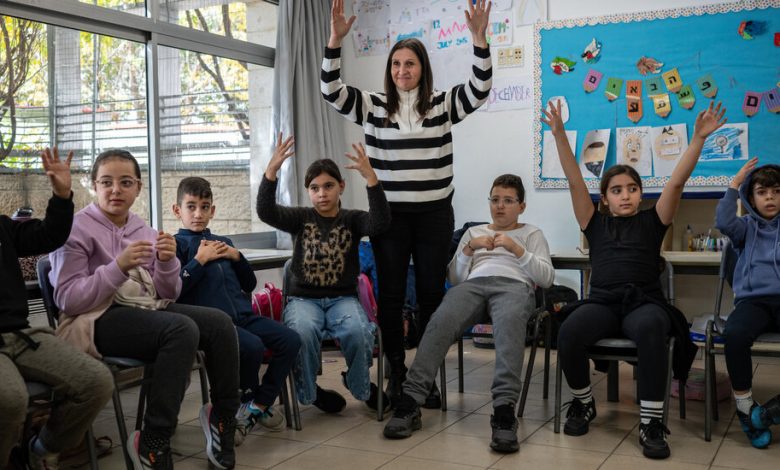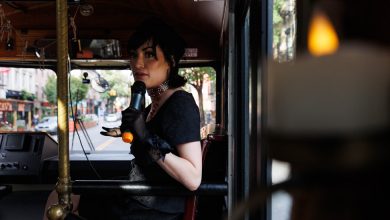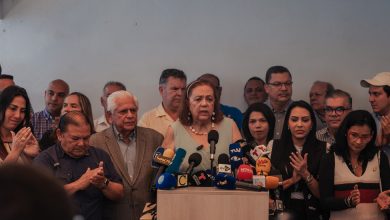At These Schools, Arab and Jewish Students Share Their Feelings, With Each Other

In a classroom decorated with Hebrew and Arabic letters, a group of third graders — their eyes closed, their hands placed facing up on their laps — took a deep breath in unison.
“And exhale,” a teacher told them.
The students, a mix of Jews and Arabs, attend Max Rayne Hand in Hand School in Jerusalem, one of six such bilingual institutions in Israel dedicated to the proposition that Israelis and Palestinians can learn and live together in peace. On a recent day in December, soon after a temporary cease-fire in Gaza collapsed and the prospect for peace seemed more distant than ever, the students were meditating.
If regional peace seemed momentarily unobtainable, at least they could try for inner calm.
Schools across Israel, most of them divided along lines of religion and language, are struggling with how to help students cope emotionally during the deadliest conflict in a generation. At Hand in Hand schools, where every class has two teachers — a Hebrew speaker and an Arabic speaker — the conversation about the Oct. 7 terrorist attacks and the subsequent war unfolding in Gaza sounds markedly different than it does in other schools.
“We might have different languages, religions and cultures, but we choose to be here together,” Haya Saleh, a Palestinian citizen of Israel and the third graders’ Arab-speaking teacher, said to her students.
As suspicions between Israelis and Palestinians are at an all-time high and support for a peace deal is at its lowest point in decades, the faculty and families who make up the Hand in Hand schools are doing the difficult work of trying to overcome those differences. And they believe they have created a model of honoring one another’s traumas, experiences and histories that can be replicated across the region.
No one at the schools is far from the war. Some Arab students have family members who have been killed in Gaza. And some Jewish students have relatives who were killed or kidnapped on Oct. 7, or who are currently serving in the military.
If peace seems possible within the schools’ walls, elsewhere in Israel it is a different story. Support for peace negotiations has fallen significantly, according to a November poll by Tel Aviv University. The poll also found that the share of Israelis in favor of a two-state solution had fallen below on-third of respondents, down from only a month prior.
That has only strengthened the resolve of the schools’ leaders. “It’s possible to be together, it’s preferable to be together, and it’s also the right thing to do,” said Gezeel Jarroush Absawy, the principal of the Hand in Hand elementary school in Haifa.
To that end, the schools emphasize processing individual and generational trauma. They present history through the lenses of both Israelis and Palestinians, and foster relationships between Arabs and Jews in childhood in the hope that they can extend into adulthood.
“We need to be friends with each other and not fight,” one student at the Jerusalem school said in Arabic. “We can live in peace,” said another in Hebrew. “Even older people and children can accept each other so we can be safe,” said another Arabic-speaking student.
The schools’ approach differs sharply from that of many schools in Israel, where a far-right government is pushing a nationalist curriculum. And it is particularly different from that in the Hamas-controlled schools that operated before the war in Gaza, where by law all classrooms were segregated by gender, girls were required to wear religious dress and textbooks did not recognize the state of Israel.
At the Hand in Hand school in Haifa, teachers recently asked students to illustrate an answer to the question: “How am I feeling at this moment?” Their responses decorated the walls.
One student drew rockets being shot from either side of the page with the words, “No no no no!” sketched in Hebrew bubble letters in the sky. Another student drew two people holding hands, wide smiles etched across their faces. A third, simply wrote, “I’m OK.”
Parents have taken part in exercises modeled on those happening in their children’s classrooms. In October, a group of parents in Haifa began meeting regularly to talk. The sessions are often moderated by two parents: Merav Ben-Nun, a Jewish Israeli, and Mouna Karkabi, a Palestinian citizen of Israel.
“We can’t stay apart and stay in our comfort zones,” Ms. Ben-Nun said in a conversation with six parents of elementary students.
“We always say it’s like making your kids vegetarians, but then you are having steak,” she explained. “If you’re bringing your kids into this very different educational system, you as a parent have to prove that you’re also there.”
Like their children’s teachers, the parents worried about what would happen to their fragile community in the immediate aftermath of Oct. 7. When Arab and Jewish parents sat down together for the first time after the attack, Ms. Ben-Nun and Ms. Karkabi asked everyone to share why they had chosen to attend the session. “We came to listen,” they recalled parents saying one after another.
The parents said they were exhausted, devastated, anxious and angry. But they also expressed a shared vision of the future, in which Israelis and Palestinians would be real partners.
“The complexity is still there, and I expect it to be there,” Ms. Karkabi said. “We don’t always agree with each other but we hear each other.”
But everything at Hand in Hand is not meditation and deep conversation. Blink and it is an ordinary school. Students fumble with their backpacks, do gymnastics at recess and race to class at the song that marks the next period.
“It’s a very happy school. It’s not always, ‘We’re Jew and Arabs!’” Ms. Salim said with a laugh. “We’re a school.”
On his drive to school one morning, Ben Vick, a Jewish fourth grader from Jerusalem, said he knew his school was unique and called the setup “cool.”
Along the way, Ben’s father drove them past apartment buildings with Israeli flags displayed outside, and another with a sign that read, “Give Peace A Chance.” Ben, 9, talked cogently about his anxiety about the war, and how his favorite subject recently switched from science to art.
“My best friend is Arab,” he said as he looked out the car’s window. “It feels fun, a religious Jew being friends with an Arab.”
The boys like going to the library together and playing soccer. But, Ben added, things are also stressful.
“It’s kind of hard to believe that there’s literally people getting killed right now,” he said as his father pulled up to the front of the school. “And here, it’s just like, chill. Another normal day.”
Arriving at school, Ben grabbed his bag and hopped out of the car. The boy’s father gave him a kiss goodbye on the head, and Ben ran into the school — hoping to find his best friend.





